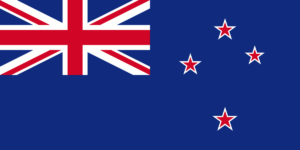History of New Zealand:
New Zealand was one of the last large tracts of land settled by humans. The first inhabitants arrived in 1000 AD. They were Moa hunters and people of Polynesian descent.
The first European to discover New Zealand was Dutch navigator Abel Tasman. British explorer James Cook began his exploration of the coast in 1769. New Zealand became a British colony in 1840. The first settlers waged war against the Māori population, but today Māori ancestry and settlers are fully integrated, and since the late 19th century, all people have the right to vote and participate in government. New Zealand officially became an independent country in 1947 with the Westminster Adoption Act.
Information about New Zealand:
| Capital | Wellington |
| Population | 5,235,521 (Source: 2023 worldometer) |
| Major Cities | Wellington (capital), Auckland, Wellington, Christchurch, Hamilton, Tauranga, Napier, Dunedin |
| Borders | Maritime borders with American Samoa (United States), Australia, Fiji, French Polynesia (France), Kiribati, Samoa, and Tonga |
| Gross Domestic Product (GDP) | $247,234,000,000 (2022 worldometer) |
| Currency | New Zealand dollar (NZD) |
Flag of New Zealand:
New Zealand Economy Key Industries:
New Zealand Major Industries: food processing, wood and paper products, textiles, machinery, transportation equipment, banking and insurance, tourism, mining
New Zealand Agricultural Products: wheat, barley, potatoes, pulses, fruits, vegetables; wool, beef, lamb and mutton, dairy products; fish
New Zealand Natural Resources: natural gas, iron ore, sand, coal, timber, hydropower, gold, limestone
New Zealand Major Exports: dairy products, meat, wood and wood products, fish, machinery
New Zealand Major Imports: machinery and equipment, vehicles and aircraft, petroleum, electronics, textiles, plastics
The Geography of New Zealand:
Total Size of New Zealand: 268,021 km² (source: world data info)
Geographical Low Point of New Zealand: Pacific Ocean 0 m
Geographical High Point of New Zealand: Aoraki-Mount Cook 3,754 m
Climate of New Zealand: Temperate with sharp regional contrasts
General Terrain of New Zealand: predominately mountainous with some large coastal plains
World Region or Continent of New Zealand: Oceania
Geographical Coordinates: 41 00 S, 174 00 E
The People of New Zealand & Culture
New Zealand Government Type: parliamentary democracy
New Zealand Nationality: New Zealander(s)
New Zealand National Holiday: Waitangi Day (Treaty of Waitangi established British sovereignty over New Zealand), 6 February (1840)
New Zealand Independence: 26 September 1907 (from UK)
New Zealand National Symbol: Southern Cross constellation (four, five-pointed stars); kiwi (bird)
New Zealand National Anthem or Song: God Defend New Zealand
New Zealand Languages Spoken: English (official), Maori (official)
New Zealand Religions: Anglican 14.9%, Roman Catholic 12.4%, Presbyterian 10.9%, Methodist 2.9%, Pentecostal 1.7%, Baptist 1.3%, other Christian 9.4%, other 3.3%, unspecified 17.2%, none 26% (2001 census)
Interesting Facts about New Zealand:
New Zealand broadcast its weather forecast in Elvish for the first time in 2012. Of course they will. This is the home of the movie “Lord of the Rings”.
New Zealand has over 400 golf courses, more golf courses per capita than anywhere else in the world.
New Zealand is famous for its adrenaline-pumping adventures, especially bungee jumping. The first commercial bungee jump was performed by his AJ Hackett in 1988 on Queenstown’s Kawarau Bridge.
Kiwi is not from New Zealand. It is actually native to China, but named after the kiwi bird.
The clearest lake in the world is Nelson’s Blue Lake, with visibility up to 80 meters.
All secondary schools in New Zealand have a law that allows them to keep 1 pound of uranium and 1 pound of thorium for use in nuclear testing. However, in the event of a nuclear explosion, a fine of $1 million will be imposed.
New Zealand was the first country to give women the right to vote in her 1893.
Bats are the country’s only endemic land mammals. The rest were introduced by Maori and Europeans.
Such a small country, New Zealand’s coastline is her ninth longest in the world at 15,134 km.
New Zealand is the third closest country to Antarctica after Chile and Argentina.
Nowhere in New Zealand is you more than 128km from the sea.
The number of Scottish piping bands per capita is higher in New Zealand than in Scotland.


